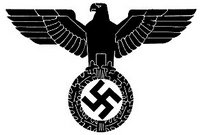Nazi Gold: The Real Story of How the World Plundered Jewish Treasures
 When the Nazis came to power the most pressing issue was an unemployment rate of close to 30%. The economic management of the state was first given to respected banker Hjalmar Schacht. Under his guidance, a new economic policy to elevate the nation was drafted. One of the first actions was to destroy the trade unions and impose strict wage controls.
When the Nazis came to power the most pressing issue was an unemployment rate of close to 30%. The economic management of the state was first given to respected banker Hjalmar Schacht. Under his guidance, a new economic policy to elevate the nation was drafted. One of the first actions was to destroy the trade unions and impose strict wage controls.The government then expanded the money supply through massive deficit spending. However at the same time the government imposed a 4.5% interest rate ceiling, creating a massive shortage in borrowable funds. This was resolved by setting up a series of dummy companies that would pay for goods with bonds. The most famous of these was the MEFO company, and these bonds used as currency became known as mefo bills. While it was promised that these bonds could eventually be exchanged for real money, the repayment was put off until after the collapse of the Reich. These complicated maneuvers also helped conceal armament expenditures that violated the Treaty of Versailles.
According to economic theory, price control combined with a large increase in the money supply should have produced a large black market, but harsh penalties that saw violators sent to concentration camps or even shot prevented this development. Repressive measures also kept volatility low, reducing inflationary pressures. New policies also limited imports of consumer goods and focused on producing exports. International trade was greatly reduced remaining at about a third of 1929 levels throughout the Nazi period. Currency controls were extended, leading to a considerable overvaluation of the Reichsmark. These policies were successful in cutting unemployment dramatically.
Most industry was not nationalized, and businesses were still motivated by pursuing profits. However, industry was closely regulated with quotas and requirements to use domestic resources. These regulations were set by administrative committees composed of government and business officials. Competition was limited as major companies were organized into cartels through these administrative committees. Selective nationalization was used against businesses that failed to agree to these arrangements. The banks, which had been nationalized by
While the strict state intervention into the economy and the massive rearmament policy led to full employment during the 1930s, real wages in
The German economy was transferred to the leadership of Hermann Göring when, on 18 October 1936, the German Reichstag announced the formation of a Four-Year Plan. The Nazi economic plan aimed to achieve a number of objectives. Under the leadership of Fritz Todt, a massive public works project, the Reichsarbeitsdienst, was started, rivaling
Another part of the new German economy was massive rearmament, with the goal being to expand the 100,000-strong German Army into a force of millions. In comparison, a military buildup had also been a part of the New Deal (regarding the Navy) and Stalin's First Five Year Plan. The Four-Year Plan was discussed in the controversial Hossbach Memorandum, which provides the "minutes" from one of Hitler's briefings. Some use the Hossbach Memorandum to show that Hitler planned a war in Eastern Europe in the pursuit of Lebensraum, believing that the Western powers of the
Nevertheless, the war came and although the Four-Year Plan technically expired in 1940, Hermann Göring had built up a power base in the "Office of the Four-Year Plan" that effectively controlled all German economic and production matters by this point in time. In 1942, the growing burdens of the war and the death of Todt saw the economy move to a full war economy under Albert Speer.
Nazi Gold
'Nazi gold' refers to the assets in gold transferred by Nazi Germany to overseas banks during the Second World War. The regime maintained a policy of looting the assets of its victims to finance the war, collecting the looted assets in central depositories. The occasional transfer of gold in return for currency took place in collusion with many individual collaborative institutions, whose identities and the precise extent of transactions have been unclear.
Acquisition
The draining of
However, this trend towards autarkic conservation of foreign reserves hides a trend of expanding official reserves, which occurred as a result of looting of assets in recently-occupied Austria and Czechoslovakia, and Nazi-governed Danzig. It is thought that these three sources boosted German official gold reserves by US$71m between 1937 and 1939. To mask the acquisition, the Reichsbank understated its official reserves (in 1939, by $40m relative to the Bank of England's estimate).
During the war, Nazi Germany continued this practice, only on a larger scale.
Disposal
The present whereabouts of the Nazi gold that disappeared into European banking institutions in 1945 has been the subject of several books, conspiracy theories, and a civil suit brought in 2001 against the Vatican Bank, the Franciscan Order and other defendants.
The Swiss National Bank, the largest gold distribution centre in continental
Croatia
Among Nazi puppet regimes, the Ustaše-controlled Independent State of Croatia also maintained concentration camps and confiscated the assets of its victims in the campaign of ethnic cleansing to clear 'Greater Croatia' of Serbs, Roma, and Jews. Victims' assets were deposited in the Croatian treasury. In 1948,
At the time of the collapse of the

<< Home